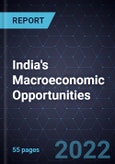Over the previous decade, the Indian economy registered robust economic growth that resulted in lower poverty rates, strong consumption growth, and a sizeable middle class. Putting behind the economic fallout from slowing economic conditions and the COVID-19 pandemic in 2019 and 2020, respectively, the Indian economy is gradually returning to a sustained growth trajectory with an 8.2% growth forecast for 2021-22. As external headwinds to economic growth mount, will rapid digitalization, a revamped foreign trade policy, manufacturing support, and an infrastructure boost sustain high economic growth beyond 2022 or will geopolitical complexities and jobless growth undermine India’s consumption and investment growth over the medium term? Which new sectors and industries will emerge as the harbingers of growth, driven by policy impetus and shifting socioeconomic factors?
This economic piece weaves pivotal policy initiatives, the demographic transformation, socioeconomic shifts, and the changing global landscape into India’s 2030 growth story. It provides insight into the economy’s future growth potential, inflation risks, monetary policy movements, the labor market transformation, and trade policy objectives until 2030. It also highlights internal and external challenges inimical to sustained economic performance, including high external fuel dependence, rising external debt, and climate change.
A key feature of this piece is the analysis of policy priorities to identify the industries poised for rapid innovation and growth. By providing a comprehensive overview of policy incentives and targets, this research service offers insight into investment opportunities in green energy, manufacturing, digitalization, infrastructure, and logistics. Besides policy priorities, insight into India’s sociodemographic transition is provided, including population composition, urbanization, consumption patterns, and the future of work (the growing gig economy is also covered). The research service also discusses high-growth sectors, including growth in affordable real estate, luxury market trade, healthcare, and tourism, based on the confluence of demographic, social, and economic transition over the next 8 years.
Through a comprehensive analysis of policy priorities, the macroeconomic outlook, and socioeconomic trends until 2030, the analyst details the economic growth opportunities for diverse stakeholders (including businesses, investors, and policymakers), even as both India and the global economy face increased uncertainties due to the Russo-Ukrainian war. This study defines the context of these opportunities and the call to action for companies that should be leveraged to drive growth. Similarly, it identifies and elaborates on the top strategic imperatives for businesses, which will be the key to ensuring growth during these rapidly transformative times.
Key Issues Addressed
- Will India be a $5 trillion economy by 2030?
- What is the medium-term inflation and monetary policy outlook for the country?
- What is India’s labor market outlook until 2030?
- What is the trade and foreign policy outlook for the country until 2030?
- What are some of the key challenges that can pose downside risks to sustainable economic growth over the medium term?
- Which growth opportunities will emerge from the policy focus on green energy, manufacturing, logistics, and infrastructure?
- How will sociodemographic factors, including population composition, urbanization, consumption, and occupation, evolve over the medium term?
- Which growth opportunities will emerge from the confluence of social, demographic, and economic factors?








